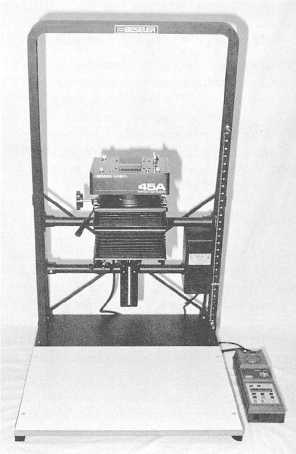PH2 Myer III
302.260
Figure 12-3.–Bessler Model 45A color enlarger.
filters either above the negative (CP filters) or below the
lens (CC filters) to control the color quality of the
exposing light.
Bessler color enlargers (fig. 12-3) are used in many
Navy imaging facilities. The Bessler Model 45A uses
pulsed-xenon tubes to expose the color printing paper.
The xenon tubes are mounted at the top of the head of
the enlarger above red, green, and blue filters. The
amount of red, green, and blue light is controlled by the
number of flashes through each color filter. By adjusting
the number or length of time that the filtered-light
sources flash, you can correct the color balance of the
print. The color head of the enlarger is normally
programmed to a color analyzer that is used to provide
acceptable color prints.
PRINTING COLOR NEGATIVES
For many years color printing was difficult to
achieve; however, through technical advances in
light-sensitive materials, chemicals, and printing
equipment, color printing is as flexible and practical as
black-and-white printing. The primary interest to you,
as a Navy Photographer's Mate, is to produce color
prints with an acceptable color reproduction of the
original scene.
Good color prints are not difficult to make. Anyone
who has normal color vision and can apply the principles
of color theory can quickly learn to make good color
prints.
NEGATIVE TO POSITIVE PROCESS
Like all negative materials, the images recorded on
color negative films are completely reversed from the
original scene as follows:
Darker hues are recorded as lighter hues;
Red is recorded as cyan;
Green is recorded as magenta; and
Blue is recorded as yellow.
To record the image as it appeared in the original
scene, you must print the color negative onto a second
tripack material-the color printing paper. If you need to
refresh your memory on the characteristics of color
printing paper, refer to chapter 2.
The theory of color printing is simple when you
think through the stages of color reproduction. Since the
colors reproduced in the color negative are
complementary to the original subject colors, a red car
is cyan in the negative. Cyan is a combination of blue
and green; therefore, the two emulsion layers in the
paper that are sensitive to blue and green are affected
when the negative is printed. Then during print
processing, yellow dye forms in the exposed portion of
the blue sensitive layer of the paper, and magenta dye
forms in the exposed portion of the green sensitive layer
of the paper. Yellow and magenta in combination
produce red; therefore, the red car is reproduced in its
original color. All the other colors form in the same way.
CUSTOM COLOR PRINTING
In black-and-white printing, the controlling
variables are primarily density and contrast. In color
printing, the variables include density and the color of
individual objects in the scene as well as the overall
color balance of the print. The mood of a color print can
be changed by altering the color balance. A winter
landscape may be printed on the blue side to intensify
12-5


